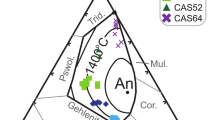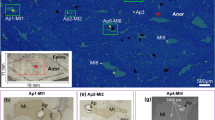Abstract
Although europium speciation in silicate melts partly reflects prevailing oxygen fugacities, melt composition and structure play the major role in determining Eu2+/ Eu3+ ratios and europium partitioning into mineral phases. Experimental evidence by different investigators on the magnitude of the compositional effect on Eu2+/Eu3+ provides consistent results only if account is taken of the oxygen buffer system employed in the experiments. The medium-dependent reduction of europium can be understood in terms of the preferential stabilization of Eu2+ by a strong aluminosilicate complex in the melt phase, and to a much lesser degree by metasilicate complexes. The stability of these complexes increases as the field strength of the associated cation species decreases. Hence Eu2+-aluminosilicate complexes are preferentially stabilized relative to trivalent lanthanides in melts of appropriate composition and their presence minimizes the enthalpy of the melt. The influence of these complexes is particularly pronounced in melts with a high feldspathic component and a strongly polymerized structure. Their petrogenetic influence is best documented through the behaviour of europium relative to the other lanthanides during “anhydrous” anatexis in high-grade metamorphic terrains and in the anomalous europium partition coefficients of phenocryst phases which formed during the crystallization of highly silicic magmas.
Similar content being viewed by others
References
Arth JG, Hanson GN (1975) Geochemistry and origin of the early Precambrian crust of northeastern Minnesota. Geochim Cosmochim Acta 39:325–362
Bohlen SR, Boettcher AL, Wall VJ, Clemens JD (1983) Stability of phlogopite-quartz and sanidine-quartz: A model for melting in the lower crust. Contrib Mineral Petrol 83:270–277
Carmichael ISE, Turner FJ, Verhoogen J (1974) Igneous Petrology. MacGraw-Hill, New York
DeJong BHWS, Brown GE (1980) Polymerization of silicate and aluminate tetrahedra in glass, melts and aqueous solutions: II. The network modifying effect of Mg2+, K+, Na+, Li+, OH−, F−, Cl−, H2O, CO2 and H3O+ on silicate polymers. Geochim Cosmochim Acta 44:1627–1642
Drake MJ (1975) The oxidation state of europium as an indicator of oxygen fugacity. Geochim Cosmochim Acta 39:55–64
Fraser DG (1975) Activities of trace elements in silicate melts. Geochim Cosmochim Acta 39:1525–1530
Frey FA, Green DH, Roy SD (1978) Integrated models of basalt petrogenesis: A study of quartz tholeiites to olivine melilitites from southeastern Australia utilizing geochemical and experimental petrological data. J Petrol 19:463–513
Fudali RF (1965) Oxygen fugacities of basaltic and andesitic magmas. Geochim Cosmochim Acta 29:1063–1075
Hanson GN (1975) REE analyses of the Morton and Montevideo gneisses from the Minnesota River Valley. Geol Soc Am Abstr 7:1099
Haskin LA, Haskin MA, Frey FA, Wildeman TR (1968) Relative and absolute terrestrial abundances of the rare earths. In: LH Ahrens (ed) Origin and distribution of the elements I. Pergamon, New York, pp 889–912
Haskin LA, Paster TP (1978) Geochemistry and mineralogy of the rare earths. In: KA Gschneidner Jr, L Eyring (eds) Handbook of the physics and chemistry of the rare earths. North Holland, Amsterdam, Vol 3:1–80
Henderson P (1982) Inorganic Geochemistry. Pergamon Press
Hess PC (1980) Polymerization model for silicate melts. In: RB Hargraves (ed) Physics of magmatic processes. Princeton University, Princeton NJ: 3–49
Hess PC, Wood MI (1982) Aluminum coordination in metaaluminous and peralkaline silicate melts. Contrib Mineral Petrol 81:103–112
Lauer HV, Morris RV (1977) Redox equilibria of multivalent ions in silicate glasses. J Am Ceram Soc 60:443–451
Mahood G, Hildreth W (1983) Large partition coefficients for trace elements in high-silica rhyolites. Geochim Cosmochim Acta 47:11–30
Morris RV (1975) Electron paramagnetic resonance study of the site preferences of Gd3+ and Eu2+ in polycrystalline silicate and aluminate minerals. Geochim Cosmochim Acta 39:621–634
Morris RV, Haskin LA (1974) EPR measurement of the effect of glass composition on the oxidation states of europium. Geochim Cosmochim Acta 38:1435–1445
Morris RV, Haskin LA, Biggar GM, O'Hara MJ (1974) Measurement of effects of temperature and partial pressure of oxygen on the oxidation states of europium in silicate glasses. Geochim Cosmochim Acta 38:1447–1459
Mysen BO, Virgo D (1978) Influence of pressure, temperature and bulk composition on melt structures in the system NaAlSi2O6NaFe3+Si2O6. Am J Sci 278:1307–1322
Mysen BO, Virgo D (1980a) Trace element partitioning and melt structure: an experimental study at 1 atm pressure. Geochim Cosmochim Acta 44:1917–1930
Mysen BO, Virgo D (1980b) Solubility mechanisms of carbon dioxide in silicate melts: a Raman spectroscopic study. Am Mineral 65:885–899
Mysen BO, Virgo D, Harrison WJ, Scarfe CM (1980) Solubility mechanisms of H2O in silicate melts at high pressures and temperatures: a Raman spectroscopic study. Am Mineral 65:900–914
Mysen BO, Virgo D, Kushiro I (1981) The structural role of alumium in silicate melts — a Raman spectrosopic study at 1 atmosphere. Am Mineral 66:678–701
Mysen BO, Virgo D, Seifert FA (1982) The structure of silicate melts: implications for chemical and physical properties of natural magma. Rev Geophys Space Phys 20:353–383
Philpotts JA (1970) Redox estimation from a calculation of Eu2+ and Eu3+ concentrations in natural phases. Earth Planet Sci Lett 9:257–268
Pride C, Muecke GK (1982) Geochemistry and origin of granitic rocks, Scourian Complex, NW Scotland. Contrib Mineral Petrol 80:379–385
Ramberg H (1952) Chemical bonds and distribution of cations in silicates. J Geol 60:331–355
Robinson CC (1974a) Multiple sites for Er3+ in alkali silicate glasses I. The principal sixfold coordinated site of Er3+ in silicate glass. J Non-Cryst Solids 15:1–10
Robinson CC (1974b) Multiple sites for Er3+ in silicate glasses II. Evidence for four sites for Er3+. J Non-Cryst Solids 15:11–29
Rollinson HR (1980) Iron-titanium oxides as an indicator of the role of the fluid phase during the cooling of granites metamorphosed to granulite grade. Mineral Mag 43:623–631
Schilling JG, Sigurdson H, Kingsley RH (1978) Skagi and western Neovolcanic zones in Iceland: 2. Geochemical variations. J Geophys Res 83:3983–4002
Schreiber HD, Lauer HV, Thanyasiri T (1980) The redox state of cerium in basaltic magmas: an experimental study of ironcerium interactions in silicate melts. Geochim Cosmochim Acta 44:1599–1612
Schreiber HD, Thanyasiri T, Lach JJ, Legere RA (1978) Redox equilibria of Ti, Cr, and Eu in silicate melts: reduction potentials and mutual interactions. Phys Chem Glasses 19:126–139
Seifert FA, Mysen BO, Virgo D (1981) Structural similarity of glasses and melts relevant to petrological processes. Geochim Cosmochim Acta 45:1879–1884
Seifert FA, Mysen BO, Virgo D (1982) Three-dimensional network structure of quenched melts (glass) in the systems SiO2-NaAlO2, SiO2-CaAl2O4 and SiO2-MgAl2O4. Am Mineral 67:696–717
Stolper E (1982) Water in silicate glasses: An infrared spectroscopic study. Contrib Mineral Petrol 81:1–17
Sun C, Williams RJ, Sun S (1974) Distribution coefficients of Eu and Sr for plagioclase-liquid and clinopyroxene-liquid equilibria in oceanic ridge basalt: an experimental study. Geochim Cosmochim Acta 38:1415–1433
Taylor M, Brown GE Jr (1979) Structure of mineral glasses I. The feldspar glasses NaAlSi3O8, KAlSi3O8, CaAl2Si2O8. Geochim Cosmochim Acta 43:61–75
Taylor M, Brown GE Jr, Fenn PM (1980) Structure of mineral glasses III. NaAlSi3O8 supercooled liquid at 805° C and the effects of thermal history. Geochim Cosmochim Acta 44:109–117
Touret J (1981) Fluid inclusions in high grade metamorphic rocks. In: LS Hollister and ML Crawford (eds) Short Course in Fluid Inclusions: Applications to Petrology, Min Assoc Canada, 182–208
Touret J, Dietvost P (1983) Fluid inclusions in high-grade anatectic metamorphites. J Geol Soc London 140:635–649
Virgo D, Mysen BO, Kushiro I (1980) Anionic constitution of 1-atmosphere silicate melts: implications for the structure of igneous melts. Science 208:1371–1373
Virgo D, Seifert FA, Mysen BO (1981) The oxidation state of europium in albite and alkali-earth silicate glasses. Carnegie Inst Wash Yearbook 80:313–316
Waff HS (1977) The structural role of ferric iron in silicate melts. Can Mineral 15:198–199
Weill DF, Drake MJ (1973) Europium anomaly in plagioclase feldspar: experimental results and semiquantitative model. Science 180:1059–1060
Author information
Authors and Affiliations
Rights and permissions
About this article
Cite this article
Möller, P., Muecke, G.K. Significance of Europium anomalies in silicate melts and crystal-melt equilibria: a re-evaluation. Contr. Mineral. and Petrol. 87, 242–250 (1984). https://doi.org/10.1007/BF00373057
Accepted:
Issue Date:
DOI: https://doi.org/10.1007/BF00373057




